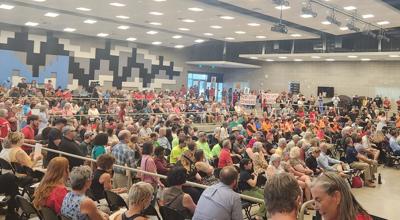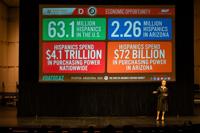
Hundreds of Tucson residents pack a meeting where city officials and developers share details about Project Blue, a proposed data center to be built just outside the city. (Stephanie Casanova / CALÓ News)
This story has been updated with a corrected quote from a source regarding penalties for water use.
Tucson residents filled a large room at Mica Mountain High School on Tucson’s southeast side on Wednesday evening, many wearing red and holding up signs protesting a proposed data center in the desert.
It was the first of a series of community meetings where Beale Infrastructure developers, who are proposing the 290-acre Project Blue data center campus in Pima County, are addressing residents’ questions about the impact the data center will have on the environment and the economy.
If approved, the data center would be north of Pima County Fairgrounds and west of Houghton Road. In June, the Pima County Board of Supervisors voted 3-2 to approve rezoning and selling the land for the project. The City of Tucson would have to annex the site in order for the project to move forward. That decision will be made in August.
During the meeting, representatives from Project Blue and the City of Tucson relayed the details of the project to hundreds of Tucsonans present. They said the project will be “net water positive,” meaning the developer will “directly invest in projects and/or fund Tucson Water efforts to conserve or secure new water resources to offset their consumptive use,” according to a City of Tucson fact sheet.
“We are not creating new water, everyone who has suggested that is correct,” said Keri Silvyn, an attorney representing Beale. “We don’t create new water. But there is water that we cannot tap into in our region that is available to us with investments and with some different strategies.”
Silvyn said the developer will build an 18-mile reclaimed water line that would bring reclaimed water to southeast neighborhoods. Those residents currently have to use potable water, she said.
“Project Blue will not reduce water flow in the river or reduce the amount of water we lose from the region,” she added.
“Yeah, right!” someone in the crowd called out. Others booed and yelled “No shame!” and “We don’t trust you!” as Silvyn tried to continue presenting.
Energy and water usage are increasingly becoming a concern for communities where data centers are built or proposed.
“Large data centers can consume up to 5 million gallons per day, equivalent to the water use of a town populated by 10,000 to 50,000 people,” according to the Environmental and Energy Study Institute. In Arizona, water resources “are under stress from climate change, a two-decade megadrought, and chronic overuse,” according to a 2024 report from the University of Arizona’s Water Resources Research Center.
The meeting was held days after Arizona Luminaria published public documents that reveal Amazon Web Services is behind the data center. Residents pointed to several non-disclosure agreements and the secrecy surrounding the project, also revealed in the article, as reasons to distrust the developer.
‘Charging more doesn’t give water back’
Shea Lambert, a biotech data scientist and software engineer who utilizes data centers on a daily basis, expressed several concerns after reading the draft agreement. The main one — which he shared with the majority present — is that nothing in the agreement restricts the developer from access to Tucsonans’ drinking water. The only penalties for the company not keeping its promises when it comes to water use are financial penalties. So Lambert did the math.
“After 30 years of them using twice as much water as they're supposed to — and its drinking water — the cost would be somewhere between $150 and $180 million,” Lambert said.
That’s not a lot of money for a company that is spending $1.2 billion in construction and $2.4 billion in equipment just in Phase 1 of the project, Lambert said.
“I've looked at the agreement up and down,” he said. “There's nothing that we can do to actually stop them or force them to finish the reclaimed pipeline. So if they decide it's in their best interest to not build the pipe and instead just pay the money and have us figure it out for 30 years, they can do that.”
When residents asked if they would establish a limit on the amount of water the data center can use, City Manager Tim Thomure and project representatives reiterated that the owners would have to pay penalties if they use more than the allotted amount of water.
“Charging more doesn’t give water back!” someone in the crowd yelled in response.
‘They’re empty promises’
Project representatives boasted of the creation of 180 jobs over a ten-year span, the estimated timeframe for building the data center.
While union members present said they were in support of the project, others questioned whether there would be a formal agreement obligating the developer to hire local union workers, pointing out that Amazon is known to be anti-union.
Beale representatives at the Wednesday meeting did not directly address questions regarding its connections to Amazon, instead insisting that Beale was the “long-term owner and landlord” of the data center.
Steve Valencia, chair of Arizona Jobs with Justice, said he understands that union workers want the jobs. But he is also concerned that without a signed contract guaranteeing those jobs go to union workers, the promises don’t mean anything.
“They're empty promises,” Valencia said. “And what we would like to see is something more secure, like negotiated collective bargaining agreements where all of the conditions of work are discussed and agreed upon and signed onto.”
‘Are we being asked to mortgage our futures?’
Kitana Ananda was the last to ask a question. She wore a red T-shirt with a Dolores Huerta illustration printed on it. She took that moment to demand answers regarding the safety of the Tucson community, which is more than 43% Latino, according to recent U.S. Census figures.
“I also want to draw attention to the fact that in addition to being an anti-union mega corporation, Amazon Web Services works with a number of tech companies, including Palantir, which is contracting with [the] federal government to surveil and police immigrants,” she said. “What is this data center going to be used for?… How do we know that this data center isn't being used to support companies that are actively targeting members of our community?”
Logan Craig, vice president of development for Beale Infrastructure, said the data center will be used for “cloud infrastructure,” technology that people use daily.
After the meeting, Ananda said the representatives didn’t have an answer to her question because they can’t guarantee the data center won’t be used for surveillance technology. They also didn’t adequately address many of the questions and concerns others asked, she said.
Ultimately, she hopes the city council rejects Project Blue.
“I'm asking myself both in terms of the uses of the data center and the resources that it's potentially using,” she said. “Are we being asked to mortgage our futures and lives to build something that is ultimately going to harm us?”
Stephanie Casanova is an independent journalist from Tucson, Arizona, covering community stories for 10 years. She is passionate about narrative, in-depth storytelling that is inclusive and reflects the diversity of the communities she covers. She recently covered the criminal justice beat at Signal Cleveland, where she shed light on injustices and inequities in the criminal legal system and centered the experiences of justice-involved individuals, both victims and people who go through the system and their impacted loved ones.















(0) comments
Welcome to the discussion.
Log In
Keep it Clean. Please avoid obscene, vulgar, lewd, racist or sexually-oriented language.
PLEASE TURN OFF YOUR CAPS LOCK.
Don't Threaten. Threats of harming another person will not be tolerated.
Be Truthful. Don't knowingly lie about anyone or anything.
Be Nice. No racism, sexism or any sort of -ism that is degrading to another person.
Be Proactive. Use the 'Report' link on each comment to let us know of abusive posts.
Share with Us. We'd love to hear eyewitness accounts, the history behind an article.